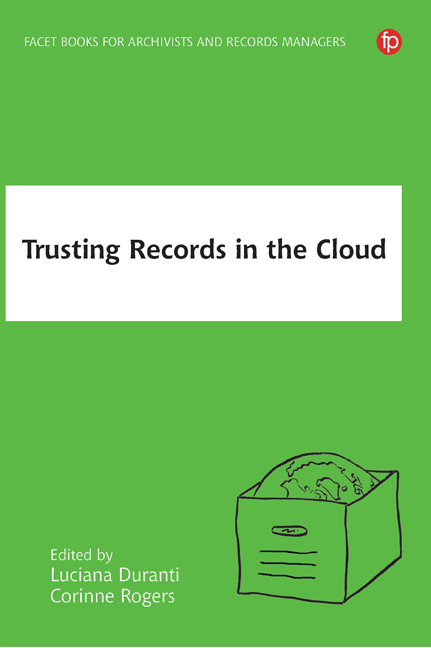Book contents
- Frontmatter
- Contents
- List of Figures and Tables
- Contributors
- 1 Introduction
- 2 The Cloud – Challenges and Issues
- 3 Open Government
- 4 Citizen Engagement
- 5 Strategies, Methods and Tools Enabling Records Governance in a Cloud Environment
- 6 Retention and Disposition
- 7 Authentication
- 8 Intellectual Control
- 9 Exploring Digital Preservation in the Cloud
- 10 Cultural Heritage – Indigenous Perspectives
- 11 The Role of the Records Professional
- 12 Education
- Appendix 1 InterPARES Trust Terminology
- Appendix 2 Products of InterPARES Trust Research
- Index
11 - The Role of the Records Professional
Published online by Cambridge University Press: 24 September 2019
- Frontmatter
- Contents
- List of Figures and Tables
- Contributors
- 1 Introduction
- 2 The Cloud – Challenges and Issues
- 3 Open Government
- 4 Citizen Engagement
- 5 Strategies, Methods and Tools Enabling Records Governance in a Cloud Environment
- 6 Retention and Disposition
- 7 Authentication
- 8 Intellectual Control
- 9 Exploring Digital Preservation in the Cloud
- 10 Cultural Heritage – Indigenous Perspectives
- 11 The Role of the Records Professional
- 12 Education
- Appendix 1 InterPARES Trust Terminology
- Appendix 2 Products of InterPARES Trust Research
- Index
Summary
Introduction
Research conducted by the InterPARES Trust (hereinafter ITrust) has addressed challenges relating to trust in a networked and digital context from a variety of perspectives. This chapter will discuss the role of the records professional in this context. ITrust defines records professional in the following way:
An individual who is trained in all aspects of managing records and information, including their creation, use, retention, disposition, and preservation, and is familiar with the legal, ethical, fiscal, administrative, and governance contexts of recordkeeping.
(Pearce-Moses, 2018, s.v. records professional)‘Records professional’ is often used as an umbrella term to include indiv - iduals working in various facets of records management and archives, regardless of job titles. The main focus of and rationale for the existence of a records professional rests on the idea of records as evidence of past activities and it is this idea that has distinguished the records professional from ancient times to modern days (Duranti and Franks, 2015, 105). Records are viewed by the records professional as ‘the currency of democracy’ (Cunningham and Phillips, 2005, 303) and as tools for creating trust through time and across societies. In order for records to function in this way, in support of, for example, accountability, the protection of rights and upholding of obligations and informed decision-making, they need to be well-organized, managed and accessible (International Organization for Standardization (ISO), 2016). Ensuring accuracy and authenticity of data, documents and records, the control of sensitive information, the maintenance of order and discoverability and the provision of access are some of the tasks that records professionals see as their role to undertake.
The identity of the records professional has to a large degree been constructed as one of a trusted custodian responsible for ensuring trustworthy records and the trustworthy management of records. The context in which records professionals act has always been complex, operating as they do within evolving legislative (e.g. Freedom of Information, Data Protection) and policy (e.g. Open Access) frameworks which sometimes contradict each other. For example, the good of open access to information and data can sometimes conflict with the good of protecting the privacy of individuals; and records professionals have to be proficient in balancing such conflicting interests and public goods. As the context in which they operate becomes increasingly networked and digital, the complexities faced by records professionals increase in parallel.
- Type
- Chapter
- Information
- Trusting Records and Data in the Cloud , pp. 223 - 244Publisher: FacetPrint publication year: 2018
- 1
- Cited by

